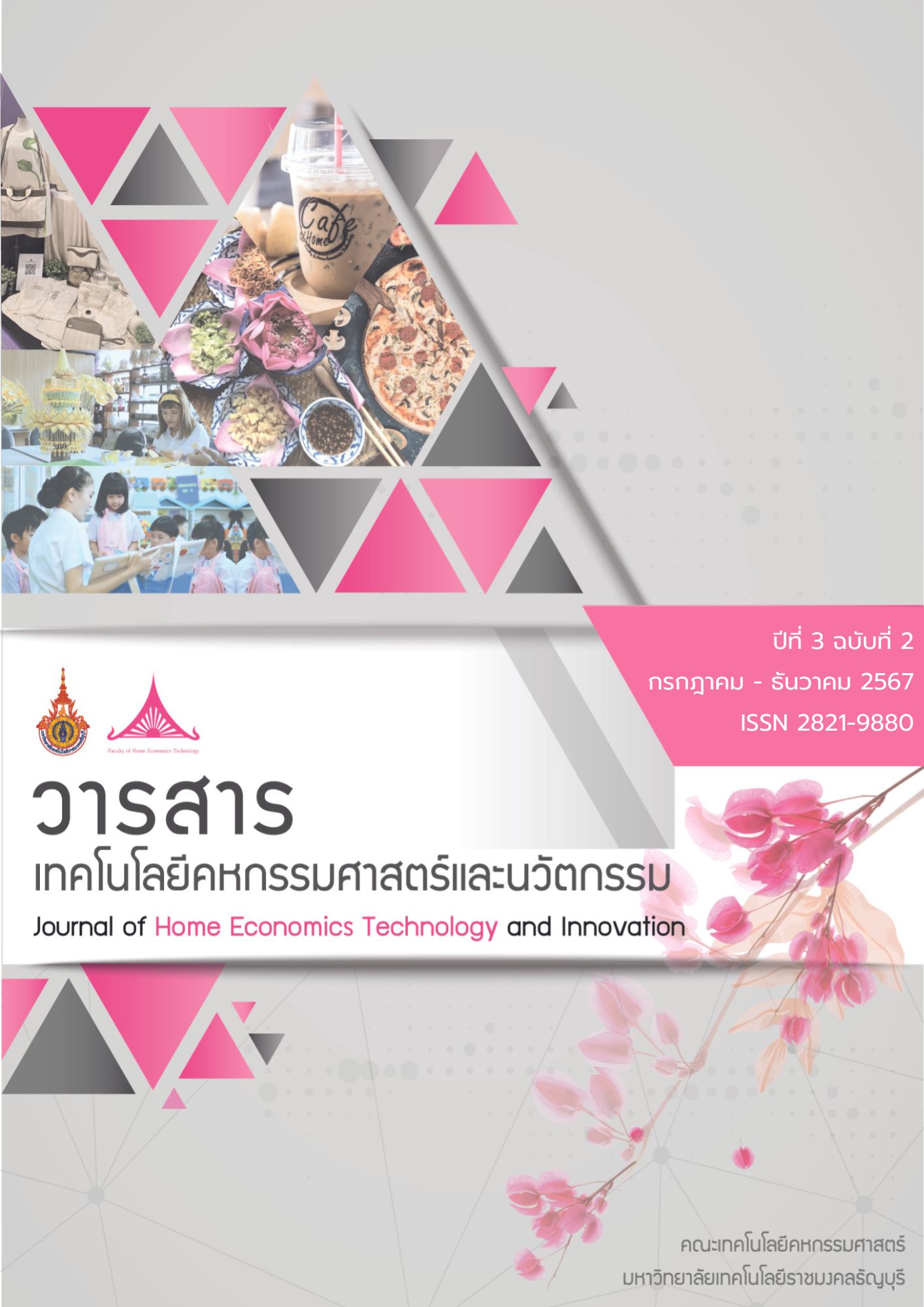Effect of organising creative art activities using loose parts materials on the cooperation behaviour of third-year kindergarten students
Main Article Content
Abstract
The purpose of this research was to examine the cooperative behaviour of third-year kindergarten students, comparing their behaviour before and after engaging in creative art activities using loose parts materials. The cluster random sampling method was used to collect a sample of 35 students, aged 5-6 years, enrolled in kindergarten 3, semester 2, and the academic year 2023 at Wat Khian Khet School in Pathum Thani Province. The research method used a one-group pretest-posttest experimental design. The research instruments included 24 creative art activity plans using loose parts materials and a cooperation behaviour observation form. The experiment duration was 8 weeks, 3 days a week, 30 minutes a day, for a total of 24 sessions. The data was statistically analysed by using the mean score and t-test dependent. The research findings revealed that: 1. Before the experiment, third-year kindergarten students had cooperation behaviour in all aspects and was at a moderate level overall. After the experiment, the students' cooperation behaviour improved in all aspects. Overall, the level of cooperation was satisfactory. 2. After organising creative art activities using loose parts materials, it was found that the third-year kindergarten students had cooperation behaviours in all aspects after the experiment, which were significantly higher than before the experiment at a statistical level of .05.
Article Details
Articles published are copyright of the Journal of Home Economics Technology and Innovation. Rajamangala University of Technology Thanyaburi The statements contained in each article in this academic journal are the personal opinions of each author and are not related to Rajamangala University of Technology Thanyaburi and other faculty members at the university in any way Responsibility for all elements of each article belongs to each author. If there is any mistake Each author is solely responsible for his or her own articles.
References
กรณ์ชพัฒน์ ดำรงค์ไชย. (25 พฤศจิกายน 2557). ความร่วมมือ. https://kaipopok.wordpress.com/2014/11/252/ความร่วมมือ/
กัญญณัฐ พลอยกระจ่าง ราชันย์ บุญธิมา และ กุลยา ตันติผลาชีวะ (2557). พฤติกรรมความร่วมมือของเด็กปฐมวัยที่ได้รับการจัด
กิจกรรมการปั้นแบบกลุ่ม. วารสารวิชาการศึกษาศาสตร์ คณะศึกษาศาสตร์ มหาวิทยาลัยศรีนครินทรวิโรฒ, 15(2), 85-93.
กุลชาติ พันธุวรกุล. (2563). การจัดกิจกรรมศิลปะสร้างสรรค์ด้วยวัสดุเหลือใช้เพื่อส่งเสริมทักษะทางสังคมของเด็กวัยอนุบาล. วารสารครุศาสตร์สาร, 14(1), 130-145.
กุลยา ตันติผลาชีวะ. (2550). การจัดกิจกรรมการเรียนรู้สำหรับเด็กปฐมวัย. กรุงเทพฯ: เบรน-เบส บุ๊คส์.
ณัฐกมล ระภานุสิทธิ์, อธิพงษ์ เพชรสุทธิ์ และมานะ ปิยะวัณเวช (2566) ผลของการจัดกิจกรรมเคลื่อนไหวแบบกลุ่มเพื่อพัฒนาทักษะทางสังคมของเด็กปฐมวัย. วารสารสังคมศาสตร์ปัญญาพัฒน์, 4(4), 101-114
ณัฐทิญาภรณ์ การะเกตุ (2563). การพัฒนาพฤติกรรมทางสังคมของเด็กปฐมวัยโดยใช้กิจกรรมศิลปะสร้างสรรค์. Journal of Modern Learning Development, 5(2), 40-54.
ณัฐรุจา ท่าโทม (2565) ผลการใช้กิจกรรมบทบาทสมมติเพื่อเสริมสร้างพฤติกรรมทางสังคมของเด็กอนุบาลในห้องเรียนพหุวัฒนธรรม. (วิทยานิพนธ์ปริญญามหาบัณฑิต) มหาวิทยาลัยบูรพา
ดรุณี เปลื้องทุกข์, ปิยะนันท์ หิรัณย์ชโลทรและปัทมาวดี เล่ห์มงคล (2566) ผลการจัดกิจกรรมกระดานที่มีต่อทักษะการทํางานร่วมกันของเด็กปฐมวัย. วารสารการบริหารจัดการและนวัตกรรมท้องถิ่น, 5(8), 84-96.
ทิศนา แขมมณี. (2560). ศาสตร์การสอน: องค์ความรู้เพื่อการจัดกระบวนการเรียนรู้ที่มีประสิทธิภาพ (พิมพ์ครั้งที่ 21). กรุงเทพฯ: สำนักพิมพ์แห่งจุฬาลงกรณ์มหาวิทยาลัย.
ธนิษฐา แจ่มอุทัย, สุพจน์ เกิดสุวรรณ์, และทองปาน บุญกุศล. (2564). ทักษะทางสังคมและความคิดสร้างสรรค์ของนักเรียนระดับชั้นปฐมวัยโดยการจัดประสบการณ์การเรียนรู้ด้วยการเล่านิทาน. วารสารการวัดผลการศึกษา, 38(104),165-173
ธนันญา ธีระธนานนท์ ปิยะนันท์ หิรัณย์ชโลทร และปัทมาวดี เล่ห์มงคล (2566). ผลการจัดกิจกรรมการเล่นสื่อวัสดุปลายเปิดที่มีต่อทักษะความสัมพันธ์ของเด็กปฐมวัย. Journal of Inclusive and Innovative Education, 7(2), 75-89.
พิไลพร สุภาพันธ์และ ชุติกานต์ เอี่ยวเล็ก (2564) ผลการจัดกิจกรรมศิลปะแบบกลุ่มที่มีผลต่อพัฒนาการด้านสังคมของเด็กปฐมวัย รายงานสืบเนื่องจากการประชุมวิชาการระดับชาติ สำหรับนักศึกษา มหาวิทยาลัยราชภัฏกำแพงเพชร ครั้งที่ 1
ไพรินทร์ บุหลัน, พวงพิศ เรืองศิริกุล, และ ชวนชม เครือเขียว. (2564). ผลการพัฒนาพฤติกรรมทางสังคมด้านความร่วมมือโดยใช้ กิจกรรมสร้างสรรค์งานประดิษฐ์เศษวัสดุชั้นอนุบาลปีที่ 2. วารสารการบริหารนิติบุคคลและนวัตกรรมท้องถิ่น, 7(4), 32-42
เยาวพา เดชะคุปต์. (2542). การจัดการศึกษาสำหรับเด็กปฐมวัย. กรุงเทพฯ: สำนักพิมพ์แม็ค.
วราลี โกศัย. (2562). การพัฒนาทักษะการคิดเชิงบริหารของเด็กปฐมวัยโดยใช้กิจกรรมศิลปะสร้างสรรค์. วารสารวิชาการศึกษาศาสตร์, 20(2), 88-101.
วัชรีย์ ร่วมคิด, ปวีณา เที่ยงพรม, และ ธนาพูน วงค์ษา (2566). ผลของการใช้กิจกรรมเกมการเล่นกลางแจ้งที่มีต่อพฤติกรรมทางสังคมของเด็กปฐมวัย. ผลของการใช้กิจกรรมเกมการเล่นกลางแจ้งที่มีต่อพฤติกรรมทางสังคมของเด็กปฐมวัย. วารสารมณีเชษฐาราม วัดจอมมณี, 6(4), 128-142.
สายชน วงสานน. (2547). การพัฒนาพฤติกรรมความร่วมมือของเด็กปฐมวัยโดยใช้กิจกรรมศิลปสร้างสรรค์เป็นกลุ่ม. (วิทยานิพนธ์ปริญญามหาบัณฑิต). มหาวิทยาลัยศรีนครินทรวิโรฒ, กรุงเทพฯ.
สำนักงานเลขาธิการสภาการศึกษา. (2564). แผนพัฒนาเด็กปฐมวัย พ.ศ. 2564-2570. บริษัท พริกหวานกราฟฟิค จำกัด.
สำนักวิชาการและมาตรฐานการศึกษา. (2560). หลักสูตรการศึกษาปฐมวัย พุทธศักราช 2560. โรงพิมพ์ชุมนุมสหกรณ์การเกษตร แห่งประเทศไทย จำกัด
Aussie Childcare Network. (2022). Benefits Of Creative Arts For Children In Early Childhood Services. Retrieved from https://aussiechildcarenetwork.com.au/
Duncan, J., Martin, S., & Haughey, S. (2018). Loose parts play: A toolkit. Scotland's Play Strategy.
Eisner, E. W. (2002). The arts and the creation of mind. Yale University Press.
Johnson, D. W., & Johnson, R. T. (2009). An educational psychology success story: Social interdependence theory and cooperative learning. Educational Researcher, 38(5), 365-379.
Loose Parts Nature Play. (2023). Building creativity one leaf and bolt at a time!. Retrieved from https://loosepartsnatureplay.org
Nicholson, S. (1972). The theory of loose parts: An important principle for design methodology. Studies in Design Education Craft & Technology, 4(2), 5-14.
Novak Djokovic Foundation. (2023). The Importance of Creative Arts in Early Childhood Education. Retrieved from https://novakdjokovicfoundation.org/


